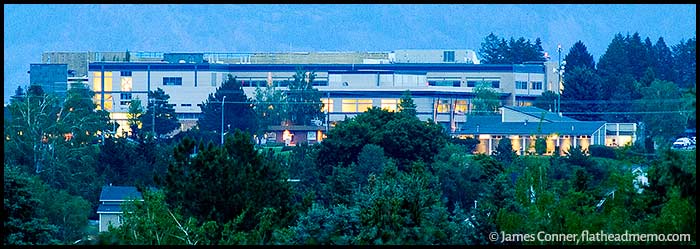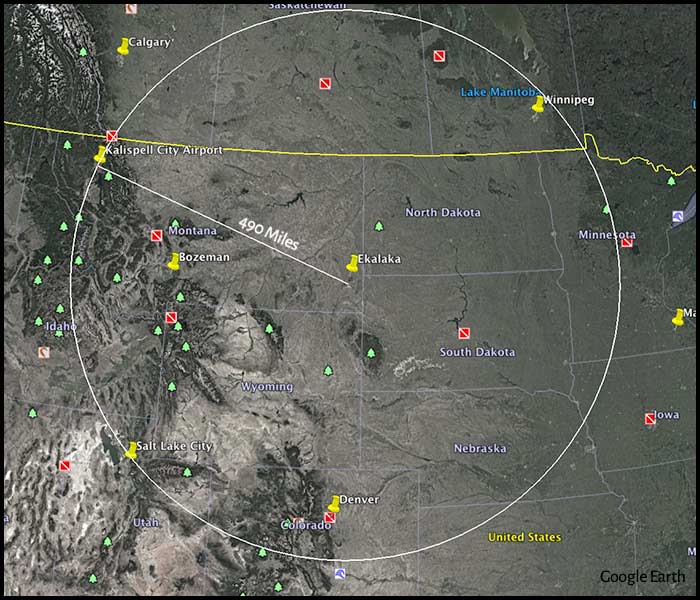20 June 2018 — 0701 mdt
Sick finances at Kalispell Regional Healthcare
won’t be cured by a damage control PR blitz
A couple of weeks ago I began receiving reports that Kalispell Regional Healthcare, in a cash crunch, borrowed money to make the payroll, and that people were being laid off. Whether a loan was needed to meet the payroll remains unconfirmed, but recent reports in the Daily Interlake and the Flathead Beacon confirm the layoffs — and reveal much more serious news:
- KRH’s building binge produced a powerful cash squeeze;
- Medicaid cutbacks forced by Republican legislators in the 2017 legislative sessions are producing a $6.6 million shortfall;
- A failure to extend expanded Medicaid, which sunsets in January, 2019, could produce a $13–14 million shortfall;
- KRH has had to set aside $21 million to cover a potential adverse outcome of a federal investigation of Medicare payments (KRH denies any wrongdoing).
Equally disturbing, at least one reader report in a newspaper’s comment section alleged that KRH has stepped up the aggressiveness of its collections operation, hounding people who had the misfortune to become ill while not being fully insured.

The lights of Kalispell Regional Hospital glow in the deep twilight on the drizzly evening of 18 June 2018 in this photograph taken from a hill approximately 1.7 miles to the west. Addition after addition have given the building a rambling, cluttered, appearance.
The federal investigation bears watching. I hope there’s no wrongdoing, no huge fines or returns of money to the government, and that no one is accused, let alone convicted, of criminal behavior.
Meanwhile, the building binge and the potential for an end to expanded Medicaid should receive the community’s immediate scrutiny.
The building binge
KRH’s ambition’s are staggering. I find myself wondering whether there’s really a need for all of the new facilities, or whether some of the expansion amounts to empire building that will increase the responsibilities, and thus the pay, of the executives running KRH. Consider, for example, the Montana Children’s Medical Center. According to the Beacon:
[KRH President and CEO Pamela] Robertson said the [center], an expansive pediatric and women’s health-care facility, was designed to be built in phases, with the first phase — the main floor encompassing “all of the intended patient space” — on track for a spring 2019 opening.
Bozeman Health Deaconess Hospital is in the midst of constructing its own $75 million women and children’s center, but Robertson isn’t worried that Montana can’t accommodate both facilities, as well as Missoula’s pediatric and women’s programs.
“The one thing that’s unique is ours is a comprehensive pediatric program, not only a NICU or high-risk OB program,” she said, explaining that Kalispell will offer pediatric oncology, surgery and neurosurgery. “We are the only full-service pediatric program in the state.”
As a statewide program, Robertson said the center will have a broad patient base from all corners of Montana, not just the Flathead Valley.
“The population of children across the state supports the pediatric program,” she said. “It does require there to be a complementary outreach strategy to support that.”
Ekalaka, 490 crow miles southeast of Kalispell, is in one corner of Montana. It may be that the imbecilities of insurance networks and such condemn the parents of sick Ekalakan children to seeking pediatric specialist care in Montana, but as the map below reveals, from a medical perspective Ekalakans have several excellent options just as close as Kalispell: Denver, Salt Lake City, and Winnipeg, Manitoba; and Minneapolis-St. Paul, and the Mayo Clinic at Rochester, MN, are only a bit farther away.
Kalispell, its spectacular combination of mountains and lakes notwithstanding, is a small community in the northwestern corner of Montana. Trying to make it the state’s center of children’s health care strikes me as an ambition that makes sense only if one carefully avoids looking at the map.
If Expanded Medicaid dies in Montana
Expanded Medicaid now serves almost 100,000 Montanans, but the legislation enabling it sunsets in January. Because Democrats most likely will not control the 2019 legislature, and because today’s Republican Party dogmatically opposes extending a healthcare program that helps tens of thousands and brings tens of millions of federal dollars into Montana , Montana’s hospitals, KRH included, and the usual progressive nonprofits, are trying to extend expanded Medicaid by passing a statutory initiative, I-185, which also slaps a heavy tax increase on tobacco to pay for the state’s share of expanded Medicaid.
Putting I-185 on the ballot requires collecting at least 25,468 signatures, and securing the signatures of at least five percent of the voters in at least 34 legislative districts (Montana has 100 legislative districts, with approximately 6,000–7,000 registered voters in each district).
The clock on signature gathering runs out on Friday, 22 June, according to the Montana Secretary of State:
Signatures due to election administrators for constitutional and statutory initiatives for certification; last day for withdrawal of signatures. Source (page 14).
When I voted at the Fairground in Kalispell at approximately 1700 on 5 June, no one was collecting signatures for I-185. Given the stakes for KRH, one would think Robertson and the board of directors would have been at the polls with clipboards, frantically gathering signatures. Maybe no signatures from Kalispell are necessary to put I-185 on the ballot. Or, given the recent excitement at KHR, perhaps the honchos were too busy answering the questions of federal investigators to deign collect signatures just to prevent a $13–14 million shortfall.
I’ve had feelers out for information on the signature gathering effort, but the people running it are keeping a very tight lid on information. We’ll know in a week. I’m not optimistic. An expanded Medicaid initiative was tried in 2014, but failed to make the ballot, and the signature gathering effort for I-185 was mighty slow getting started.

